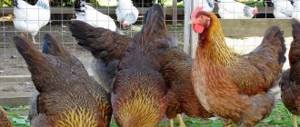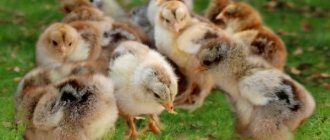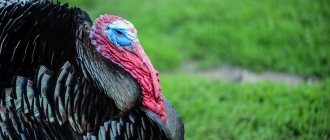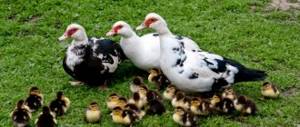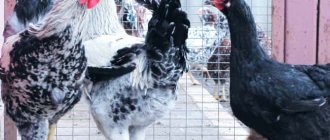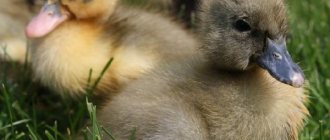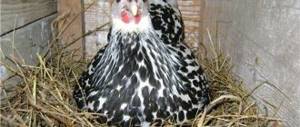2 201
no comments yet
2
Author:
Rasskazov Pavel.
Reading time: 3 minutes
Chickens that are obtained by mixing two, three or more different breeds are called crosses. This type of crossbreeding was invented and introduced to produce birds with unique qualities.
Crosses are superior to maternal or paternal lines in one or more characteristics.
Crossbreeding technology
The process of creating a new bird is called crossbreeding. To implement it, representatives of two different breeds (lines) with the best productivity indicators are required. Depending on the orientation of the resulting bird, chickens and roosters of egg or meat breeds are taken. A more complex crossbreeding option is possible, when the resulting hybrid will be crossed again with a third line or cross of chickens.
Expert opinion
Sadchikov Nikolay Alekseevich
Veterinarian ornithologist
Ask a Question
The radical difference between breeding crosses and simple interbreeding is that such an animal is the end result of poultry farming. Theoretically, it is possible to obtain offspring from cross-bred birds, but in terms of their qualities they will be significantly inferior to the maternal line. In practice, crosses are used for their intended purpose, and are subsequently clogged. Egg hybrids are disposed of immediately as soon as they lose their egg production. Meat birds are slaughtered even earlier, as soon as they gain the required weight.
Chicks from banal interbreeding are successfully used for further breeding of a new line or improving the qualities of the parent breed.
Popular breeds
Let's look at the most popular cross breeds among Russian farmers.
Master Gray
Master Gray - French selection. The hybrid has gray-white feathers and is ideal for growing on small farms. Productivity is high, complex care and special feed are not needed. The breed's legs are massive, its body is large, and its plumage is pockmarked. On the wings, braids and neck the pattern is quite light and dark, the lobes with the comb are red and small. The breed is distinguished by high immunity and general endurance, and is not sensitive to temperature changes. Its only drawback is that it is impossible to get offspring at home.
Kuchinskaya
Kuchin chickens and roosters have a fleshy, strong body, brown color, and large bones. The down is gray; roosters may have red feathers. The head is medium in size, with a five-toothed comb. The legs are short, the wings of cockerels are light, and those of hens are dark. The birds grow quickly, laying up to 250 eggs per year. The Kuchinsky breed is considered precocious; females begin to lay eggs at the age of 6 months, including in the winter season.
The Kuchin Jubilee breed of chickens is an exceptional breed created at the State Poultry Farm of the Moscow Region
Bielefelder
Bielefelders are beautiful, highly productive birds of German origin. They are distinguished by good frost resistance, calm temperament, and high egg production. The color is unusual, memorable - it is dominated by black and gold shades. The colors of roosters and hens are slightly different - hens have a red head and neck, belly, and sides are brown, while roosters have an ocher head, neck, and back, and small spots of white are scattered throughout the body. The breed produces high quality meat and large eggs, and the hens lay eggs well.
Loman Brown
The weight of Loman Brown birds is relatively small, the body is small and neat, the body is set vertically. The head is small, the crest is well developed and red in color. The plumage is quite dense, the legs are high, the wings are small. The shell is strong, white or brown in color, and the eggs are quite large in size. The safety of young animals reaches 98%.
Loman Brown are chickens that are successfully bred in poultry farms and private farms.
It is impossible to obtain full-fledged offspring of most crosses at home - you need to buy young animals or hatching eggs.
Bresgalskaya
Bresgal chickens produce tender meat. The birds grow large and lay large eggs. The color of the feathers is white, almost like snow. The crest is bright red, the legs are blue. By the way, the national flag of France completely repeats the “color scheme” of the chickens of the breed.
Wyandotte
Hardy and calm birds that can come with different plumage - from white to black. In Russia, silver and white Wyandottes are most often grown. The body is compact, round, earrings, lobes, red comb, brown eyes, very short wings. The legs are not very large, the tail is small and fluffy. The birds lay eggs early, take good care of their offspring, get along well with other breeds, and are ideal for raising for fattening.
Despite their small stature, Wyandotte chickens are excellent layers, producing 120 eggs per year.
Wyandots love strawberries and can trample their beds.
Goloshennaya
Exotic bare-necked chickens, which are more similar to turkeys, have poor plumage and can easily tolerate even very harsh growing conditions. The breed is easy-going, has a neck without feathers. The comb is red, the earrings are large, the beak is slightly curved, scarlet, the eyes are orange, the wings hang down on the sides and fit tightly to the body. The tail is small but voluminous. Cockerels weigh about one and a half to two times more than hens. Productivity is high, plumage can have different colors.
Legbar
Legbars are funny birds with a lush, round body and small legs. Instead of a crown, they have a small crest. The comb is red, moderately developed, and has earrings. The weight of an adult individual rarely exceeds 3 kg. The feathers are dense, lush, thick. The back is straight, smoothly blending into the tail. Plumage colors are cream, ashy; in cockerels the shade is usually more saturated. The character is curious, lively, active. Leaders can fight.
Legbar chickens are distinguished by their beautiful appearance, peaceful, quiet character, high egg production and high-quality dietary meat.
Hungarian giant
The Hungarian giant grows quickly, produces high-quality meat, quickly adapts to different growing conditions, and has a massive body with lush plumage. The tail is medium, slightly deviating from the vertical direction. The braids are medium, round. The comb has no pronounced teeth, the lobes are light and round. The neck is quite long, the legs are thin, unfeathered. One of the most unpretentious breeds.
Brown Nick
Brown Nick crosses produce good eggs and are ideal for beginning farmers. Productive breed, egg type. The character is calm and flexible. The birds are omnivores, produce viable chicks, and can be raised on the floor or in cages. The shade of the down is brown, the comb is small, erect, leaf-shaped. The eggs are large, with a brown shell. No special conditions are needed for chickens.
Directions of crosses
The main qualities for which chickens are bred are egg production and the ability to quickly grow a large volume of meat. Depending on what maternal and paternal breeds participated in the creation of the cross, chickens can be:
- egg;
- meat;
- meat and eggs.
The most popular egg birds
Good breeds of egg-laying chickens will produce about 180-200 eggs per year. This is a good indicator for the animal, especially since such egg production will continue for several years. However, breeders have developed crosses that produce up to 330-350 eggs per year. Such productivity will become much lower in the second year of the bird’s life, by which time the chickens are slaughtered.
Puberty in egg crosses begins early: by the age of four months, the hen begins to lay eggs. Despite the ability to lay virtually one egg every day, egg crosses have very poor instincts - they will not hatch eggs. Therefore, you should not expect brood hens among these birds.
The most popular egg crosses are:
Hisex White: a cross with good egg production
Look
Loman White: beautiful birds bred in Germany
More details
Loman Brown is a cross from Germany that brings great financial profit to its owners
Further
Czech dominant: features of the cross, varieties, productivity
Look
The most popular meat crosses
Meat crosses, also known as broilers, are birds created to gain muscle mass as quickly as possible with minimal waste of feed. The average size of a broiler at the time of slaughter is 4-5 kg. The bird reaches this mass by 37-45 days. Most modern beef varieties are based on a mixture of Cornish and White Plymouth Rock breeds.
Today the most common meat crosses are:
Broiler Ross 308 – meat cross of chickens
Look
Gibro-6 – early ripening broilers with good meat productivity
Read
Broiler Cobb 700 – extra-heavy meat hybrid
More details
Broiler Cobb 500 – Czech meat chickens with vigorous growth
Further
The most popular meat-egg crosses
If the farm is small and private, then it is most profitable to breed combined birds, which have good egg production and quickly gain weight.
Such chickens will produce less meat and eggs than pure meat or egg crosses, but such versatility allows the bird to be used to produce both eggs and meat.
The most popular in Russia are:
Master Gray: cross with high productivity rates
Look
Hercules is a cross with high meat productivity and an unusual ability to lay eggs with two yolks
More details
Broiler Ross 708 – cross with high rates of meat productivity and egg production
Read
Detailed descriptions of the best breeds and crosses
Below is a table with the most popular breeds and crosses of chickens in Russia. For convenience, all crosses and breeds are divided into categories.
| Meat | Meat and eggs | Egg | Decorative and fighting |
| Brahma Broiler Jersey Giant Dorking Cochin Cornish Langshan Malin, Mechelen Cuckoo Orpington Plymouthrock Faverolles | Australorp Adler silver Ameraucana Amrox Andalusian Appenzeller Araucana Arshotz Barbezier Barnevelder Bielefelder Breda Brekel Bress Gallic Welsumer Hungarian Giant Westphalian Totlegers Wyandotte Hamburg Gergebil Hercules Hollow-necked Dominant Jersey Giant Dominic Yerevan Zagorskaya salmon Sundheimer Icelandic Landrace Cat Lyarevskaya Red Star Red Cap Crevecoeur Kuchinskaya Jubilee Curly Laflash Lakenfelders Legbar Maran Master Gray Megrula Moscow black Niederhainer New Hampshire Orlovskaya Ostfriesian gull Pavlovskaya Pantsirevskaya Pervomayskaya Poltava clayey Polverara Pushkinskaya Redbro Rhineland Rhode Island Russian crested Gray Kyrgyz Sussex Tetra Ukrainian long-haired Foxy Chicken Vorwerk Harka or Harko Tsarskoe Selo Black bearded Black Star Alsatian Jur Lovskaya vociferous | Ancona Andalusian blue Borkovskaya Brown nick Brekel Italian partridge Coral Leghorn Lohmann brown Minorca Russian white Russian crested Ushanka Hi-Line Hisex Brown Czech Golden Shaver | Azil Appenzeller Araucana Ayam Tsemani Bantam Breda Brekel Hamburg Chinese silk Lafleche Millefleur Pavlovskaya Paduan Uzbek Fighting Phoenix Shabot |
The catalog is periodically updated and replenished with new breeds with detailed descriptions and photos.
What is a line
Within each chicken breed, breeders develop several lines with better qualities than the rest of the breed. Over time, the lines degenerate and the bird loses its productivity. To prevent this from happening, the lines are periodically crossed with each other, which makes it possible to preserve or restore the useful qualities of the animal.
Efficiency of chicken crosses (egg direction)
Statistics
Egg-crossed chickens are more productive than their purebred counterparts. If hybrids produce more than 300 eggs per year, then purebred laying hens produce about 200 eggs. Moreover, crosses, unlike purebred chickens, actively lay eggs only in the first year of life.
Are hybrids suitable for private backyards?
Crosses are more in demand at poultry farms, where there are specialists in breeding highly effective hybrids, and it is easier to create the necessary conditions for the birds.
At the same time, nothing prevents farmers from purchasing young crosses for their subsidiary farms. The main difficulty here is creating the necessary conditions for the birds and the fact that the breeder will have to annually update the stock by buying new cross-breed chickens.
That is why small farmsteads most often use purebred laying hens, which are much less hassle and are capable of producing eggs over a long period of time.
Differences between laying hybrids
Egg-cross chickens lay brown or white eggs. The shade of the shell depends on the color of the laying hen's plumage. Brown crosses are slightly inferior in egg production to their white relatives. But at the same time they are larger - when slaughtered they produce more meat. They have more eggs and it is easier to care for such chickens, as they are calmer and unpretentious in keeping.
Unlike white hybrids, they have different colors for males and females, making it easier to sort the chickens. A small disadvantage of motley hens is that they consume more feed than white ones. Accordingly, the cost of their testicles is slightly higher.
White and brown eggs
The color of a chicken egg shell depends on the breed of laying hen, and, according to experts, does not in any way affect the taste of the eggs or the amount of nutrients they contain.
Experts call the opinion that brown shells are stronger than white shells a myth. The thickness of the eggshell depends on the feed and the age of the bird, not the color. The main difference between eggs is that dark ones are larger than white ones.
What is a hybrid bird
A hybrid, in contrast to a cross, is the crossing of different taxa of a bird (for example, an Indian duck).
One of the popular hybrids in recent years is a cross between a chicken and a guinea fowl. Such selection requires special knowledge and skills, since the resulting hybrid is not always viable. Over time, technologies for producing young animals were developed. The resulting poultry has higher quality meat in terms of protein and amino acid composition than broilers.
Excellent 2
The best crosses
Since today there are quite a lot of crosses. Crosses are a hybrid of two or more breeds or populations (lines) of chickens of high... both egg and meat production, poultry farmers have a truly huge choice of whom to breed.
For those who specialize in the production of chicken eggs, German cross Loman Brown chickens are ideal. In recent years, crossesCrosses are a hybrid of two or more breeds or populations (lines) of chickens of high... based on this breed, they have overtaken the famous Leghorn breed in popularity in the past. In fact, in each country the breed is represented by several intra-breed types,... If all the rules of keeping and nutrition are followed, the egg production of these birds reaches 300-320 eggs per year, which is really a lot.
At the same time, Loman Brown chickens perform well both in large poultry farms and in small farms, giving almost the same results. Another advantage is the relatively low cost of young animals.
In second place in popularity today is the Hisex Brown cross, bred on the basis of the New Hampshire and Leghorn breeds. In fact, in each country the breed is represented by several intra-breed types, .... The egg production of these birds reaches 280-315 eggs per year, which is slightly less than Loman Brown. At the same time, the Highsex Brown cross chicken lays fairly large eggs in both white and light brown shells. Another advantage of the cross is the low cholesterol content in eggs, which makes them perhaps the most dietary.
The Tetra SL cross can be placed in conditional third place. These chickens do not take root well in private backyards, since strict adherence to living conditions is extremely important to maintain their high productivity. They lay 300-310 brown eggs per year. The disadvantage of the breed is that each laying hen requires 120-150 g of feed per day.
Among meat crosses, Crosses are a hybrid of two or more breeds or populations (lines) of chickens of high... in Russia, primarily domestic hybrids are popular. In addition to the crosses already mentioned above, Crosses are a hybrid of two or more breeds or populations (lines) of high-quality chickens... we should also mention the Smena-2 broilers, which account for at least a third of the chicken produced in the country. The bird of this cross gains weight of 2.3 kg on the 42nd day. This is perhaps the most popular cross of meat chickens.
In second place in popularity among meat hybrids is the SK Rus-2 cross, which produces approximately a sixth of the chicken produced in Russia. The cross is adapted to the conditions of the south of the country and cage keeping. On day 42, the broiler gains 2.1 kg of weight.
Finally, third place is shared by two similar crosses, “Competitor” and “Competitor-2,” created in the Moscow region. About a tenth of the country's chicken comes from these birds.
The best meat and egg breeds
Among meat-egg crosses, the following breeds are considered the best:
Breeds such as “Borki”, “Belorus-9”, “Lohmann” are often found on private farmsteads. These crosses are capable of producing up to three hundred eggs per year.
For a small family, having 10 birds is quite enough. You can keep ten chickens of different breeds in separate chicken coops.
Any chicken coop for 10 chickens must be warm. The minimum temperature that should be in the room is -2 degrees.
In order for chickens to lay eggs consistently, it is necessary to organize lighting in the chicken coop: provide windows and electric lamps.
Read also: Hungarian high-flying pigeons: history of origin, description, content
Each breed has its own requirements for housing density. Broilers are kept in a room with a stocking density of no more than three chickens per square meter. Egg breeds do well at a density of four birds per square meter. When keeping chickens in winter, you can increase the stocking density to six birds. This way they can withstand the cold better.
Broiler-M
Broiler-M chickens were created by cross-breeding female mini-hens and roosters of other breeds (for example, Cornish). Representatives of the cross are distinguished by a compact body and short legs. The carcass of an adult rooster weighs about 3 kg, a chicken - 2.5 kg.
These birds do not require large areas when kept; they grow well both on deep litter and when kept in cage batteries. With small dimensions, mini-chickens lay relatively large eggs (60-65 grams). At the age of two months, a Broiler-M broiler carcass can weigh from 1.5 to 1.8 kilograms.
Broiler 61
Broiler chickens of the Broiler 61 breed were created by crossing the Cornish and Plymouthrock breeds, incorporating their best qualities. Birds are characterized by a relatively high rate of weight gain at low feed costs.
The average live weight of one individual at one and a half months of age can be 1800 grams, and at one and a half months of life it is about 1.8 kilograms. This, of course, is not a record, but the figure is quite high. In addition to the excellent maturation speed, Broiler 61 chickens have good egg production and a high percentage of offspring survival
It should be noted that the egg productivity of the cross is very average. The positive differences of the Broiler 61 breed include the high percentage of survival of young animals. Characterized by cross breeding and rapid growth of chickens. Gourmets note the unique taste of meat.
What are cross chickens?
A cross is a line, parent birds and the resulting hybrid offspring. There are “two-,” “three-,” and “four-line” options. The number in the name of a particular “cross breed” may indicate the number of lines used.
The vast majority of new highly productive crosses for both egg and meat production are based on 4-linear hybrids.
They are bred to increase both egg and meat productivity.
Based on the color of their egg shells, crosses are divided into two types: white and brown.
All white crosses are the result of crossing matching lines of white leghorns. Browns can also use Leghorns, but lines from such breeds as Rhode Island, New Hampshire, and others are also used. In this case, Leghorns transfer improved egg production to the hybrids, but the white color of the shell is lost.
Colored crosses produce more massive birds with higher safety, but reduced egg production.
And, despite the increased mass of eggs, the costs of raising them are higher. This is due to the increased ratio between consumed feed units and the yield of the final product.
Crosses with brown egg shells are in great demand. They are much calmer, can withstand the stress of working conditions more easily, and are more resistant to heat.
In addition, feather coloring makes it easier to sort day-old chicks by sex (less labor costs).
As a result, global production of brown eggs is constantly increasing.
In Belgium, their share of sales in 2013 was about 70%, in the UK - more than 85%, in Spain and Italy 86% each, and in France - 96%.
In the USA, Holland and Germany, the demand for white eggs traditionally remains, but the trend is similar there, and not only exports are growing, but also consumption within the market.
Companies all over the world are trying to use different crosses, constantly experimenting in search of the best options.
Some large poultry farms use dozens of crosses at once, trying to buy breeding material in several countries.
When choosing livestock for industrial poultry farming (including maternal flocks), professionals focus primarily on the genetic potential and productivity of the cross.
The photo shows the Hungarian hybrid Tetra SL.
ROSS-308
Broilers of this cross gain muscle mass very quickly. Within 24 hours, a chicken of the ROSS-308 broiler breed increases its weight to 60 grams. Already at the end of the ninth week of fattening, broilers are ready for slaughter, i.e. reach a weight of 1600-2500 grams.
Broiler chickens of the ROSS-308 breed have good egg production and hatch quite viable chickens, which is not so common among crosses. On store shelves, these chickens can be recognized by their pale skin color.
The main advantages of the cross:
- early maturity, short fattening periods;
- high carcass weight;
- unpretentiousness to food and maintenance;
- good egg production.
The ROSS-308 broiler breed is chosen by owners of small and medium-sized poultry farms for raising meat and egg chickens. It is not uncommon in poultry farms.
Video “ROSS-308 Broilers 36 days”
In the video you can watch broiler chicks at one month of age in home conditions.
COBB–500
The main distinguishing feature of the KOBB-500 cross is the slightly yellowish color of the skin, even if feed was used that does not contain yellow pigment at all. For some reason, this quality is very attractive to buyers of chicken carcasses at the market and in stores.
The plumage of these chickens is mostly white. Broiler chickens of the KOBB-500 breed are characterized by excellent early maturity and at the time of slaughter (40-45 days) weigh approximately 2500 grams.
It is not without reason that chickens of the KOBB-500 cross are popular among poultry farmers, since, as experience shows, they have an almost ideal ratio of growth rate with proportional accumulation of muscle mass. The presence of red and white meat in the carcass is proportional.
The COBB-500 breed is bred for:
- rapid increase in live weight;
- low cost of carcasses;
- high white meat content;
- omnivorous;
- good survival of young animals.
The productivity of KOBB-500 is influenced by housing conditions, quantity and quality composition of feed.
Video “COBB-500 chickens in a brooder”
The video shows chickens of the KOBB-500 cross at the age of several days.

